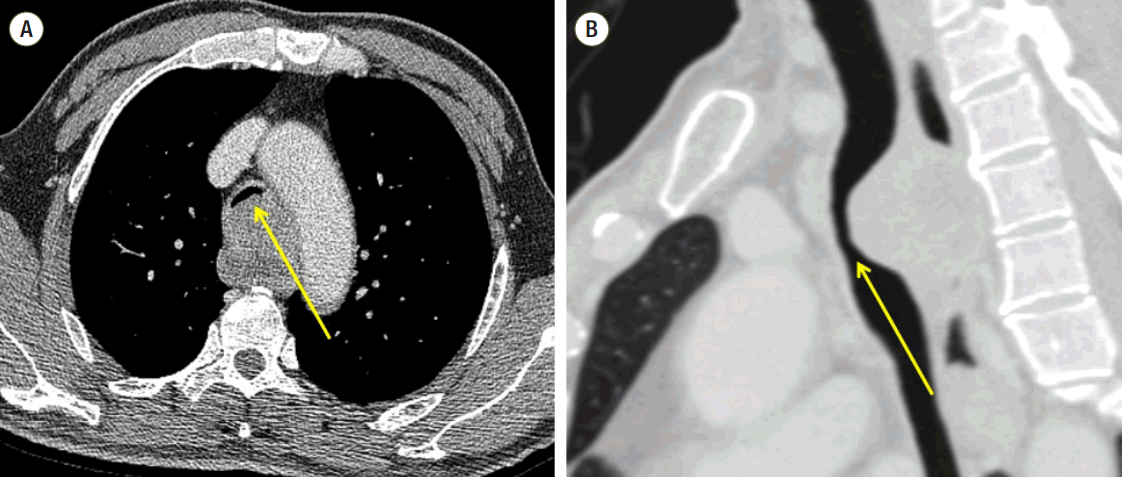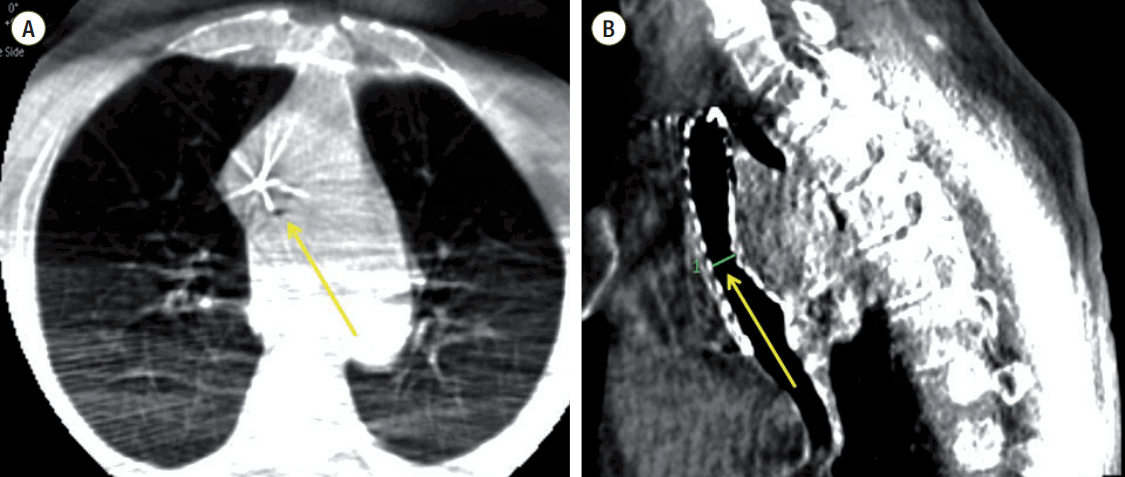Abstract
A 60-year-old man with advanced esophageal cancer was admitted for surgical placement of a feeding jejunostomy tube before commencement of chemoradiotherapy. His esophageal cancer had directly invaded the posterior tracheal wall, inducing a nearly total obstruction of the distal trachea. On the day before the surgery, respiratory failure developed due to tumor progression and tracheal edema. Tracheal intubation and mechanical ventilation were attempted without success. Application of veno-venous extracorporeal membrane oxygenation (ECMO) corrected the patient’s respiratory acidosis and relieved his dyspnea. With full ECMO support, he underwent tracheal stent insertion. Two hours later, he was weaned from ECMO support uneventfully. This was a successful case of tracheal stenting for airway obstruction under rescue veno-venous ECMO.
Up to 25% of esophageal cancers invade adjacent structures, such as the bronchus, trachea, and aorta.[1] Esophageal cancer can induce airway obstruction via extrinsic compression or via direct invasion due to the anatomical position of tumors inside the mediastinum.[2] In the case of airway problems, airway resection and reconstruction in advanced esophageal cancer is technically challenging and has poor post-surgical outcomes.[2,3] Therefore, rapid decision-making and proper management are often the only ways to prolong life. As the use of veno-venous extracorporeal membrane oxygenation (ECMO) for respiratory support has increased, application of ECMO has emerged an effective option in airway emergency.[4] We demonstrated a case of tracheal stenting for airway obstruction under rescue veno-venous ECMO.
A 60-year-old man was transferred to our institution with a diagnosis of advanced esophageal cancer. He presented with three months of dysphagia, cough, and chest discomfort. A mass was located 27 to 35 cm from the upper incisor, and endoscopic biopsy confirmed squamous cell carcinoma. CT scan images showed that the esophageal cancer had caused lower tracheal narrowing and suspicious tracheal invasion with metastatic mediastinal lymph nodes. Clinical stage was T4N+Mx, and 18F-FDG PET was planned to assess for the presence of other metastatic lesions. We performed a fiber-optic bronchoscopy to evaluate the severity of tracheal invasion. The tumor caused tracheal stenosis five to ten centimeters below the vocal cords (Fig. 1). However, the distal airway was patent passing through the tumor.
The patient was admitted to our department for feeding jejunostomy, which provides stable enteral feeding during chemo-radiation treatment. On the day before the surgery, he experienced severe dyspnea and a sense of impending suffocation. Labored breathing and stridor were observed upon physical examination, and respiratory distress became aggravated very quickly. Tracheal intubation and mechanical ventilator support were required to allay the onset of respiratory fatigue. He was transferred to a surgical intensive care unit in a sitting position, as he was unable to tolerate a supine position. After ICU admission, an examination showed a blood pressure of 200/118 mmHg, heart rate of 103 beats per minute, and respiration rate of 35 breaths per minute on a nasal cannula with 6 L oxygen per minute. We believed critical tracheal stenosis was a cause of respiratory failure. Potentially, tracheal intubation and conventional mechanical ventilation could be ineffective in this patient because of pre-existing central airway obstruction. In case of failed trachea intubation, we prepared bedside ECMO simultaneously.
The endotracheal tube could not bypass the tumor. Following administration of 4 mg midazolam and 100 mg succinylcholine considering rapid onset and short duration, a small-sized endotracheal tube (with an inner diameter of 6.0 mm) was placed temporarily just above the tumor. A flexible fiber-optic bronchoscopy-guided intubation also failed because the tumor was very hard and unmovable. The bronchoscopy revealed a narrowed, slit-like tracheal lumen with check-valve opening just below the tip of the endotracheal tube. Mechanical ventilation was ineffective, with a feeling of airway resistance. Arterial blood gas analysis revealed severe respiratory acidosis without hypoxia (pH 7.14; PCO2 97 mmHg; PO2 551 mmHg; base excess -0.9). We applied bedside veno-venous ECMO immediately. Before ECMO cannula insertion, 2000 IU of an anticoagulant (heparin) was administered. We used the Capiox Emergency Bypass System (Terumo, Inc., Tokyo, Japan) and cannulated the right femoral vein and left femoral vein with 21 French size vascular cannulae (Right; Medtronic Biomedicus cannula®, Left; DLP cannula®, Medtronic, Minneapolis, Minnesota), using Seldinger’s technique. After ECMO was in place, a flow of 3.0-3.5 L/min on 1,500-1,600 rpm was sustained. Soon arterial blood partial pressures of oxygen and carbon dioxide were normalized, and respiratory symptoms were relieved. However, some episodes of complete airway obstruction developed during the ECMO procedure. Because of the inoperability of the tumor, an expandable metallic stent was planned to achieve stable patent airway as a palliative treatment. Pre-procedure CT scans showed pin-point narrowed trachea (Fig. 2A). A Terumo guide wire was thin enough to pass the narrowest point via an endotracheal tube without any disruption. After placing the guide wire, we removed the endotracheal tube to insert the tracheal stent (18 mm x 7 cm) via sequential fluoroscopic guidance. A post-procedure CT image revealed that the narrowest tracheal lumen was dilated to 8 mm (Fig. 2B). The whole procedure was completed safely under veno-venous ECMO support while the patient was awake in radiologic intervention room. Dyspnea disappeared and self-expectoration became possible. Two hours later, the patient was weaned off veno-venous ECMO without incident, after a total of 44 hours of use. He had no neurologic deficits after ECMO removal. Palliative chemotherapy was started after discharge.
The appropriate management of acute airway obstruction consists of early detection of underlying causes and immediate intervention. Unexpected total tracheal obstruction is a challenging situation for physicians, even experienced anesthesiologists and thoracic surgeons. In this patient, the progression of tracheal obstruction was much faster than expected.
Veno-venous or veno-arterial ECMO has a great role as a bridge or supporting treatment for acute management of central airway obstruction that is unimproved by cricothyroidotomy or tracheostomy.[5] Tracheal stenosis due to esophageal cancer was controlled by using an airway stent, as reported by Chao et al, in 2005.[6] Also, previous cases showed that veno-venous ECMO provided effective pulmonary or cardiopulmonary support during elective endobronchial procedures.[7] However, elective airway stenting under general anesthesia is not as challenging as rescue intervention for acute airway obstruction if stable vital signs are maintained before impending arrest.
Malignant airway obstruction is intraluminal tumor growth or extrinsic compression of the airway by a tumor. Dyspnea, cough, and wheezing are commonly the symptoms of airway obstruction. However, if resting dyspnea occurs (usually accompanied by stridor, retraction, and use of accessory muscles), immediate action is necessary. In these cases, the airway diameter is usually less than 5 mm, which is critically narrow.[8]
Application of ECMO for advanced cancer patients induces some debates about limited resources, financial issues, and poor cancer prognoses. Also, it is not easy to determine whether to use an invasive intervention on an advanced cancer patient. Furthermore, palliative care intervention should be individualized considering the severity of the emergency, performance status, patient/family concerns, and cultural factors.[9,10] Razi et al reported that timely airway stenting results in improvement of survival times and significant cost savings in malignant central airway obstruction in patients with advanced cancer.[11] Also, airway stenting facilitates weaning from mechanical ventilation.[12,13] Ultimately, quality of life and performance status improved.[11] In this case, even though the patient was diagnosed with advanced esophageal cancer, he has not been evaluated systematically and he was naïve for chemo-radiation therapy with fair performance status recently. A stable patent airway is essential during chemo-radiation therapy. Use of emergency ECMO combined with tracheal stenting was a lifesaving method, and a satisfactory early outcome was achieved. Consequently, the patient had a last chance to get definitive and palliative treatment.
This case demonstrated that veno-venous ECMO can be useful in a situation of acute airway obstruction as a bridge therapy in safe manner. By timely application of veno-venous ECMO before impending arrest requiring cardiac support, the patient was provided more stable and less invasive management. In conclusion, successful rescue with veno-venous ECMO from acute airway obstruction was feasible.
References
1. Fujita H, Sueyoshi S, Tanaka T, Tanaka Y, Matono S, Mori N, et al. Esophagectomy: is it necessary after chemoradiotherapy for a locally advanced T4 esophageal cancer? Prospective nonrandomized trial comparing chemoradiotherapy with surgery versus without surgery. World J Surg. 2005; 29:25–30.

2. Seto Y, Chin K, Gomi K, Kozuka T, Fukuda T, Yamada K, et al. Treatment of thoracic esophageal carcinoma invading adjacent structures. Cancer Sci. 2007; 98:937–42.

3. Matsubara T, Ueda M, Nakajima T, Nakagawa K, Yamashita T, Horikoshi N, et al. Can esophagectomy cure cancer of the thoracic esophagus involving the major airways? Ann Thorac Surg. 1995; 59:173–7.

4. Hong Y, Jo KW, Lyu J, Huh JW, Hong SB, Jung SH, et al. Use of venovenous extracorporeal membrane oxygenation in central airway obstruction to facilitate interventions leading to definitive airway security. J Crit Care. 2013; 28:669–74.

5. Willms DC, Mendez R, Norman V, Chammas JH, et al. Emergency bedside extracorporeal membrane oxygenation for rescue of acute tracheal obstruction. Respir Care. 2012; 57:646–9.

6. Chao YK, Liu YH, Hsieh MJ, Wu YC, Liu HP, Wang CJ, et al. Controlling difficult airway by rigid bronchoscope- an old but effective method. Interact Cardiovasc Thorac Surg. 2005; 4:175–9.
7. Kim JE, Jung SH, Ma DS. Experiences of tracheal procedure assisted by extracorporeal membrane oxygenator. Korean J Thorac Cardiovasc Surg. 2013; 46:80–3.

9. Levy MH, Smith T, Alvarez-Perez A, Back A, Baker JN, Block S, et al. Palliative care, Version 1.2014. Featured updates to the NCCN Guidelines. J Natl Compr Canc Netw. 2014; 12:1379–88.
10. Bosscher MR, van Leeuwen BL, Hoekstra HJ. Surgical emergencies in oncology. Cancer Treat Rev. 2014; 40:1028–36.

11. Razi SS, Lebovics RS, Schwartz G, Sancheti M, Belsley S, Connery CP, et al. Timely airway stenting improves survival in patients with malignant central airway obstruction. Ann Thorac Surg. 2010; 90:1088–93.

Fig. 1.
CT scans show the narrowest tracheal lumen. (A) Axial view. The diameter of tracheal lumen was measured 5 mm. (B) Sagittal view.

Fig. 2.
CT scans during stenting. (A) Pre-procedure CT scan shows pin point tracheal lumen, which was much narrower compared with Fig. 1A. (B) Post-procedure CT scan shows a widen lumen, which was measured 8 mm.





 PDF
PDF ePub
ePub Citation
Citation Print
Print



 XML Download
XML Download